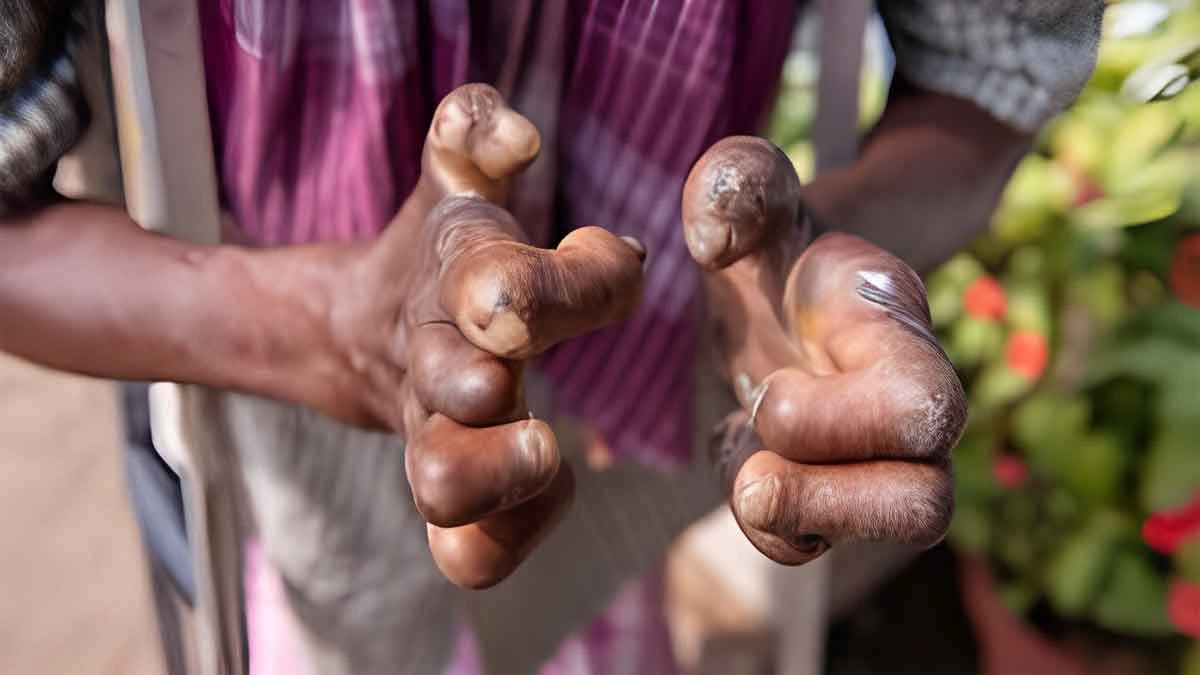
Leprosy, a disease that has captured human attention for centuries, often evokes a mix of curiosity and stigma. Despite its historical association with isolation and fear, modern understanding of leprosy has evolved significantly. This blog post aims to shed light on the complexities of leprosy by presenting 25 intriguing facts that highlight its medical, social, and cultural dimensions. From its prevalence in certain regions to the advancements in treatment and ongoing research, these facts will provide a comprehensive overview of this often-misunderstood condition. Join us as we explore the realities of leprosy, dispelling myths and fostering a deeper understanding of its impact on individuals and communities around the world.
Leprosy and Mycobacterium leprae: Leprosy, also known as Hansen’s disease, is an infectious disease caused by the bacterium Mycobacterium leprae. This bacterium is unique as it cannot be cultured in vitro, which makes studying it challenging. M. leprae primarily targets the skin and peripheral nervous system, leading to the characteristic symptoms of leprosy, including skin lesions and nerve damage. The bacterium is an obligate intracellular pathogen, meaning it can only survive and replicate inside human cells, particularly macrophages and Schwann cells.
Affected Areas: Leprosy primarily affects the skin, peripheral nerves, mucosal surfaces, and eyes. The skin lesions can vary from light patches to nodules, and they may be accompanied by a loss of sensation due to nerve damage. Peripheral nerves are particularly vulnerable, leading to complications such as muscle weakness and deformities. In severe cases, the eyes can be affected, leading to vision problems or blindness. The disease’s impact on these areas can significantly affect a person’s quality of life, resulting in social stigma and isolation.
Historical References: Leprosy has been recognized for over 4,000 years, with references found in ancient texts from civilizations such as India and Egypt. The disease was often associated with punishment or divine retribution, leading to social ostracism of those affected. Historical records indicate that leprosy was prevalent in various cultures, and it was often treated with isolation in leper colonies. These colonies were established to separate individuals with leprosy from the general population, reflecting the fear and misunderstanding surrounding the disease.
Global Incidence: Approximately 200,000 new cases of leprosy are reported globally each year. This figure may not fully represent the actual number of cases, as many individuals may remain undiagnosed due to stigma, lack of access to healthcare, or insufficient awareness of the disease. The incidence of leprosy varies by region, with higher rates found in tropical and subtropical areas. Efforts to improve detection and treatment have been ongoing, but challenges remain in reaching all affected individuals.
Incubation Period: The incubation period for leprosy can range from 5 to 20 years, although symptoms may appear as early as 1 year after exposure to the bacterium. This long incubation period makes it difficult to trace the source of infection, as individuals may not exhibit symptoms for many years. During this time, an infected person can transmit the bacterium to others, contributing to the spread of the disease. Understanding the incubation period is crucial for public health strategies aimed at controlling leprosy.
Contagiousness and Immunity: Leprosy is not highly contagious; approximately 95% of people have a natural immunity to the disease. This means that most individuals can come into contact with the bacterium without becoming infected. The transmission occurs primarily through prolonged close contact with untreated individuals, particularly in environments where healthcare access is limited. The low contagiousness of leprosy contributes to the ongoing misunderstanding and fear associated with the disease.
WHO’s Public Health Declaration: The World Health Organization (WHO) declared leprosy a public health problem in 1991, which catalyzed global efforts to control the disease. This declaration aimed to raise awareness, improve access to treatment, and reduce stigma. The WHO initiated the Global Leprosy Strategy, which focuses on early diagnosis and treatment to prevent disability and transmission. Since then, significant progress has been made, but challenges remain in certain regions where stigma and lack of resources hinder effective control.
Registered Cases: As of 2020, there were approximately 200,000 registered cases of leprosy worldwide. This number reflects the efforts of various health organizations to track and treat the disease. However, it is important to note that many individuals may remain unregistered due to barriers such as stigma, lack of awareness, or inadequate healthcare infrastructure. Continuous efforts are needed to ensure that all affected individuals receive proper diagnosis and treatment.
Geographical Distribution: Brazil, India, and Indonesia account for about 80% of all reported leprosy cases. These countries face unique challenges in controlling the disease, including socioeconomic factors, healthcare access, and cultural beliefs. In India, for instance, a significant number of new cases are reported annually, necessitating ongoing public health initiatives. The concentration of cases in specific regions highlights the need for targeted interventions to address the unique circumstances of each area.
Forms of Leprosy: Leprosy is classified into two main forms: paucibacillary (PB) leprosy, which has 5 or fewer skin lesions, and multibacillary (MB) leprosy, which has more than 5 lesions. This classification is crucial for determining the appropriate treatment regimen. Paucibacillary leprosy generally indicates a milder form of the disease with fewer bacteria present, while multibacillary leprosy signifies a more severe infection with a higher bacterial load. The distinction between these two forms also affects the duration of treatment; patients with PB leprosy typically require 6 months of multi-drug therapy (MDT), whereas those with MB leprosy need about 12 months of treatment. Understanding these classifications helps healthcare providers manage the disease effectively and tailor treatment to individual patient needs, ultimately reducing the risk of complications and transmission.
Multi-Drug Therapy (MDT): The treatment for leprosy involves multi-drug therapy (MDT), which is provided for free by the World Health Organization (WHO). MDT typically consists of a combination of antibiotics, including dapsone, rifampicin, and clofazimine. This combination is effective in killing the Mycobacterium leprae bacteria and preventing the development of drug resistance. MDT has been a significant advancement in leprosy treatment, leading to a dramatic decrease in the number of cases and the associated stigma. The WHO recommends MDT as the standard treatment for all forms of leprosy, and it is available at health facilities in endemic regions worldwide.
Cure Rate of MDT: MDT has proven to be highly effective in curing leprosy, with a cure rate of over 99%. The success of MDT is attributed to its ability to eliminate the bacteria from the body, which not only cures the patient but also significantly reduces the risk of transmission to others. The treatment is well-tolerated, and most patients experience a significant improvement in their symptoms within a few months. The high cure rate underscores the importance of early diagnosis and treatment in preventing complications and disabilities associated with the disease.
Duration of Treatment: The average duration of treatment with MDT for paucibacillary (PB) leprosy is 6 months, while for multibacillary (MB) leprosy, it is 12 months. This duration is based on clinical studies that have shown these timeframes to be effective in curing the disease. Completing the full course of MDT is crucial to ensure that the bacteria are completely eradicated from the body, preventing relapse and further transmission. Adherence to the treatment regimen is essential, and healthcare providers often support patients throughout their treatment journey to encourage compliance and monitor for any side effects.
Complications of Untreated Leprosy: Leprosy can cause permanent damage to the skin, nerves, limbs, and eyes if not treated early. The nerve damage can lead to a loss of sensation, making individuals more susceptible to injuries and infections. This can result in deformities, particularly in the hands and feet, and may lead to disability. In severe cases, untreated leprosy can cause blindness due to damage to the eyes. The physical and social consequences of these complications can have a profound impact on the lives of affected individuals, leading to isolation and discrimination.
Stigma and Social Barriers: The stigma associated with leprosy has been a significant barrier to treatment and social integration. Many individuals with leprosy face discrimination, which can lead to social isolation, loss of employment, and difficulty accessing healthcare. Cultural beliefs and misconceptions about the disease often exacerbate this stigma, making it challenging for affected individuals to seek help. Public health campaigns aimed at raising awareness and educating communities about leprosy are essential in combating stigma and encouraging those affected to come forward for diagnosis and treatment.
Transmission Mechanism: Leprosy is primarily transmitted through droplets from the nose and mouth during close and frequent contacts with untreated cases. The transmission does not occur through casual contact or touching, which contributes to the misunderstanding surrounding the disease. The bacterium can remain in the environment for extended periods, but it requires prolonged exposure for transmission to occur. Understanding the transmission mechanism is crucial for developing effective public health strategies to control the spread of leprosy.
Demographics of Leprosy: The disease is most common among adults, but children can also be affected. The majority of new cases occur in individuals between the ages of 15 and 45, but leprosy can manifest in younger children as well. The susceptibility of children to leprosy highlights the need for awareness and preventive measures in communities where the disease is prevalent. Early diagnosis in children is particularly important, as it can help prevent the development of disabilities and reduce transmission within families and communities.
New Cases in 2019: In 2019, there were 202,185 new cases of leprosy reported globally. This number reflects ongoing efforts to diagnose and treat the disease but also indicates that leprosy remains a public health challenge in many regions. The data emphasizes the importance of continuous monitoring and intervention strategies to control the disease, particularly in countries with high incidence rates. Public health initiatives aimed at increasing awareness, improving access to healthcare, and reducing stigma are critical in addressing the ongoing burden of leprosy.
Prevalence in Tropical and Subtropical Regions: Leprosy, also known as Hansen’s disease, shows a significant prevalence in tropical and subtropical regions of the world, particularly in rural areas where access to healthcare may be limited. The disease is caused by the bacterium Mycobacterium leprae, which thrives in warm environments. Countries like India, Brazil, and Indonesia report the highest incidence rates, often linked to socio-economic factors such as poverty, lack of education, and inadequate healthcare infrastructure. The rural setting can exacerbate the spread of the disease due to close-knit communities and limited awareness about its transmission and treatment.
Male-to-Female Ratio: Research indicates that leprosy affects men more frequently than women, with a male-to-female ratio of approximately 1.5 to 1. This discrepancy may be attributed to various factors, including biological differences in immune response and social behaviors that increase exposure risk among men. Additionally, cultural factors may influence the reporting and diagnosis of the disease, as men might be more likely to seek treatment for visible symptoms. Understanding this gender disparity is crucial for targeted health interventions and awareness campaigns.
Discovery of Effective Treatment: The first effective treatment for leprosy was discovered in the 1940s with the introduction of the antibiotic dapsone. This marked a significant breakthrough in the management of the disease, as dapsone effectively inhibits the growth of Mycobacterium leprae. Initially, dapsone was used as a monotherapy, but over time, the development of multidrug therapy (MDT) became the standard of care, combining dapsone with rifampicin and clofazimine to prevent drug resistance and improve treatment outcomes. This advancement has dramatically reduced the global burden of leprosy.
New Cases in India: According to the World Health Organization (WHO), in 2018, approximately 60% of new leprosy cases were reported from India alone. This statistic underscores the ongoing public health challenge posed by leprosy in the country, despite the availability of effective treatments. Factors contributing to this high prevalence include socio-economic disparities, stigma associated with the disease, and insufficient healthcare access in rural regions. Efforts to enhance awareness, early detection, and treatment adherence are essential to reduce new cases in India.
Disabilities from Untreated Cases: Leprosy can lead to significant disabilities in about 70% of untreated cases, impacting mobility and overall quality of life. The disease primarily affects the skin, nerves, and mucous membranes, leading to nerve damage that can result in loss of sensation and muscle weakness. This can cause injuries and infections that go unnoticed due to the lack of feeling, ultimately leading to deformities and disabilities. Early diagnosis and treatment are vital to preventing these complications and improving the quality of life for affected individuals.
Diagnosis Methods: The diagnosis of leprosy is primarily based on clinical symptoms, which may include skin lesions, nerve damage, and sensory loss. Healthcare providers may also use skin smears and biopsies to confirm the presence of Mycobacterium leprae. The clinical examination is crucial, as leprosy can often be misdiagnosed due to its similarity to other skin conditions. Timely and accurate diagnosis is essential for initiating treatment and preventing the progression of the disease.
Vaccine Research: Currently, there is no vaccine available for leprosy, though research is ongoing to develop one. The complexity of the disease and its causative agent presents challenges in vaccine development. However, studies are exploring various approaches, including using existing vaccines, like the Bacillus Calmette-Guérin (BCG) vaccine, which has shown some efficacy in providing protection against leprosy. Continued research efforts are crucial for finding an effective vaccine to prevent the disease and reduce its incidence globally.
Frequently Asked Questions about Leprosy:
What causes leprosy?
- Leprosy is caused by bacteria, primarily Mycobacterium leprae, and to a lesser extent, Mycobacterium lepromatosis. These bacteria primarily affect the skin and peripheral nerves.
How is leprosy contagious?
- It’s believed that leprosy is spread through respiratory droplets, meaning it’s transmitted when someone with untreated leprosy coughs or sneezes, and another person inhales those droplets during prolonged, close contact.
- It’s important to understand that casual contact, such as shaking hands or sitting next to someone, does not typically spread leprosy.
- Also, once a person starts the multidrug therapy treatment, they quickly become non-infectious.
What does leprosy look like?
- Leprosy manifests in various ways, but common signs include:
- Pale or reddish skin patches with reduced sensation.
- Thickened or enlarged nerves, often with loss of sensation or muscle weakness.
- Skin lesions that may be flat, raised, or nodular.
- Because the nerve damage can cause a loss of feeling, injuries can go unnoticed, and this is what can lead to further complications.
Why are most people immune to leprosy?
- A significant majority of people have a natural immunity to Mycobacterium leprae.
- This means that even if they come into contact with the bacteria, their immune system can effectively fight it off, preventing them from developing the disease.
- It is estimated that around 95% of people have natural immunity to the bacteria.
- Factors influencing immunity are still being researched, but it’s believed to involve genetic predisposition and overall immune system health.
Key takeaways:
- Leprosy is curable with multidrug therapy.
- It is much less contagious than historically thought.
- Early diagnosis and treatment are crucial to prevent disabilities.
- Stigma surrounding leprosy is a large problem, and it is important to spread accurate information.









